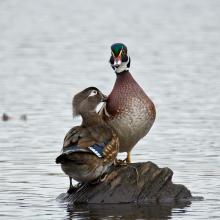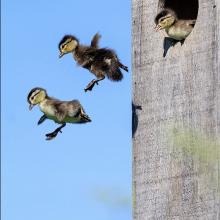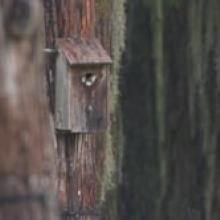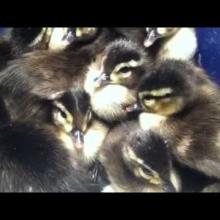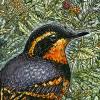

Join BirdNote tomorrow, November 30th!
Illustrator David Sibley and actor H. Jon Benjamin will face off in the bird illustration battle of the century during BirdNote's Year-end Celebration and Auction!
Birds are often admired for their ability to fly. But braking just in time to avoid a crash landing is amazing by itself. How does a robin go from full-out flight to a dead stop at a tree? If we could watch in slow motion, we’d see it raising the angle of its wings higher and higher from the horizontal. A hawk dives a bit below where it wants to perch, then pulls into a steep climb, slowing its momentum. And this female Wood Duck will use a combination of raised wings and a bit of hydroplaning with her wide, webbed feet to land on water.
This show brought to you by The Bobolink Foundation.
BirdNote®
How Do Birds Brake From Flight?
Written by Bob Sundstrom
This is BirdNote.
Watch any backyard bird, and you're watching an acrobat at work. A robin flaps swiftly across your field of vision and — reaching a tree — appears to go from full-out flight to a dead stop in the wink of an eye.
How come it doesn't crash?
If we could watch in slow motion, we'd see that just before it gets there, the robin raises the angle of its wings higher and higher from the horizontal. This increases drag on the bird, slowing it down. It also decreases the lift the robin has achieved in flapping forward, allowing it to drop down as needed. And the tail can also be fanned and held down, adding to the drag at the instant before the bird clamps its feet to the perch. [Music]
And hawks - at high speed, a hawk dives to a bit below where it wants to perch, then pulls into a steep climb, slowing its momentum just in time. While ducks landing on a pond use a combination of raised wings and a bit of hydroplaning — like water-skiing — on their wide, webbed feet. [Mallard flying in, landing on water]
Birds are often admired and envied for possessing the miracle of flight. But braking just in time is a minor miracle in itself.
For BirdNote, I'm Mary McCann.
###
Bird sounds provided by The Macaulay Library of Natural Sounds at the Cornell Lab of Ornithology, Ithaca, New York. Mallard landing on water [133222] recorded by M J Anderson
"The Banjo Op. 15 (Fantasie Grotesque)" from the album Gottschalk, Louis Moreau (1829-1869): American Piano Music, 1995 Smithsonian Folkways Recordings, performed by Amiram Rigai
BirdNote’s theme music was composed and played by Nancy Rumbel and John Kessler.
Producer: John Kessler
Executive Producer: Dominic Black
© 2015 Tune In to Nature.org June 2018 / March 2023 Narrator: Mary McCann
ID# flight-09-2018-6-28






